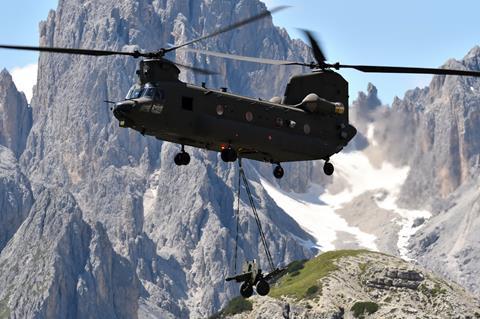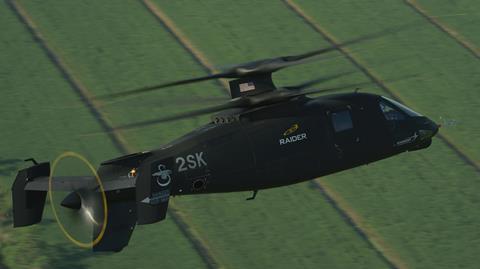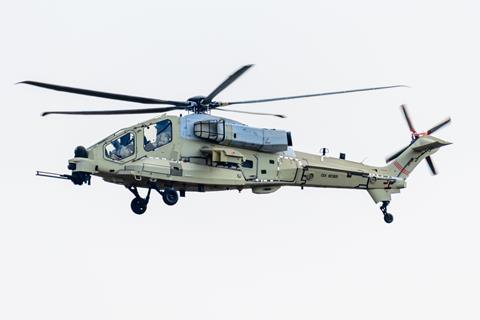The Italian army sees a future need for a next-generation rotorcraft to augment the capabilities of its conventional helicopter fleet, according to the service’s aviation chief.
Major General Andrea Di Stasio, commander of Italian army aviation, says a high-speed capability would be “complementary to our traditional helicopters”.

Rome has yet to define an official requirement for a fast rotorcraft and is still considering all possible architectures – whether a tiltrotor design or one based around Sikorsky’s X2 technology – but Di Stasio sees the higher speed and range offered as “increasing survivability” for aircraft and crews.
“We are analysing everything, but we are quite sure that Italy needs new rotorcraft with increased operational range and greater airspeed,” he adds. “But we are conscious that this capability is not yet mature.”
In that regard, Italy has been looking at the US Army’s Future Vertical Lift (FVL) programme and NATO and EU next-generation rotorcraft studies in order to ensure technological convergence and platform interoperability. It is “following with particular interest” the recent selection of the Bell V-280 for the US Army’s Future Long Range Assault Aircraft requirement, it says.
Italy’s need for speed and range from part of its rotorcraft fleet is driven by the extended area of the Mediterranean in which the army needs to operate.
Di Stasio is conscious that the country will work with rotary-wing champion Leonardo Helicopters to ensure it plays a central part in any future development.
“Anyway, for the future… we believe in co-operation and partnership between different countries, whether European or other Western nations.”
Attempts to forge partnerships are already under way: Italy is involved in the NATO Next Generation Rotorcraft Capability (NGRC) programme and is one of several nations who are observing the USA’s FVL process; Leonardo, meanwhile, is the joint leader of a parallel European technology maturation programme.

Colonel Pier Luigi Verdecchia, head of the industrial cooperation office at the Italian defence ministry, says it “will seek engagement for our national industry [to ensure] significant technological work share on any programme”.
Verdecchia, who has been deeply involved with the NGRC project since its inception and is now the Italian national representative for its concept phase, stresses that he sees high-speed technology as the true game-changer – the other attributes being analysed by the initiative could all be applied to traditional helicopter designs, he says.
The primary goal for the new requirements will be to ensure aircraft survivability in high-threat environments, while at the same time providing new maintenance and logistic concepts which will reduce down-time to a minimum, revolutionising the way aviation operations are conducted, he adds.
Verdecchia emphasises that Italy has no current preferred solution but will prioritise whichever guarantees “that national requirements are met and industrial engagement is taken into consideration”. He also points out that although a high-speed rotorcraft can always slow down if the operational situation dictates, the reverse is not true for a conventional helicopter.
“We will then decide which will be our way to develop the next-generation rotorcraft for the Italian armed forces and in particular for the army.”
Italy is looking to develop a joint programme for all branches of its armed forces where the services’ needs will be brought together in order to find the best compromise, in order to seek commonalities, cost reduction and operational efficiency, he adds.
Leonardo Helicopters already has a certain degree of expertise in tiltrotor technology through its development of the AW609 and the ongoing Next Generation Civil Tiltrotor technology demonstrator project. However, both are civil programmes.

Modernisation and rationalisation of the service’s wider fleet is already under way, says Di Stasio, with legacy Bell utility types – the 212, 412, 206 JetRanger and UH-1 – being replaced by the Leonardo Helicopters AW169M.
The AW129 Mangusta attack helicopter, meanwhile, will be succeeded by the developmental AW249, now known as the Fenice – or Phoenix.
Two Fenice prototypes are ready but at the moment only one is flying, Di Stasio says. The army intends to acquire a total of 48 examples of the new type, which should enable the gradual replacement of the AW129 from 2027.
The design of the AW249 is based on the operational experience developed by Italian army aviation in the employment of the Mangusta but also from Leonardo’s expertise, for instance, through the use dynamic components from the AW149 transport.
It is powered by twin GE Aerospace CT7 engines, and will be armed with a 20mm cannon, guided and unguided rockets, and air-to-air and air-to-surface missiles, including Rafael’s Spike ER2.
The Italian army also operates NH Industries NH90s and Boeing CH-47F Chinooks.
Di Stasio and Verdecchia were speaking on the sidelines of Defence IQ’s International Military Helicopter conference in London on 22 February.































